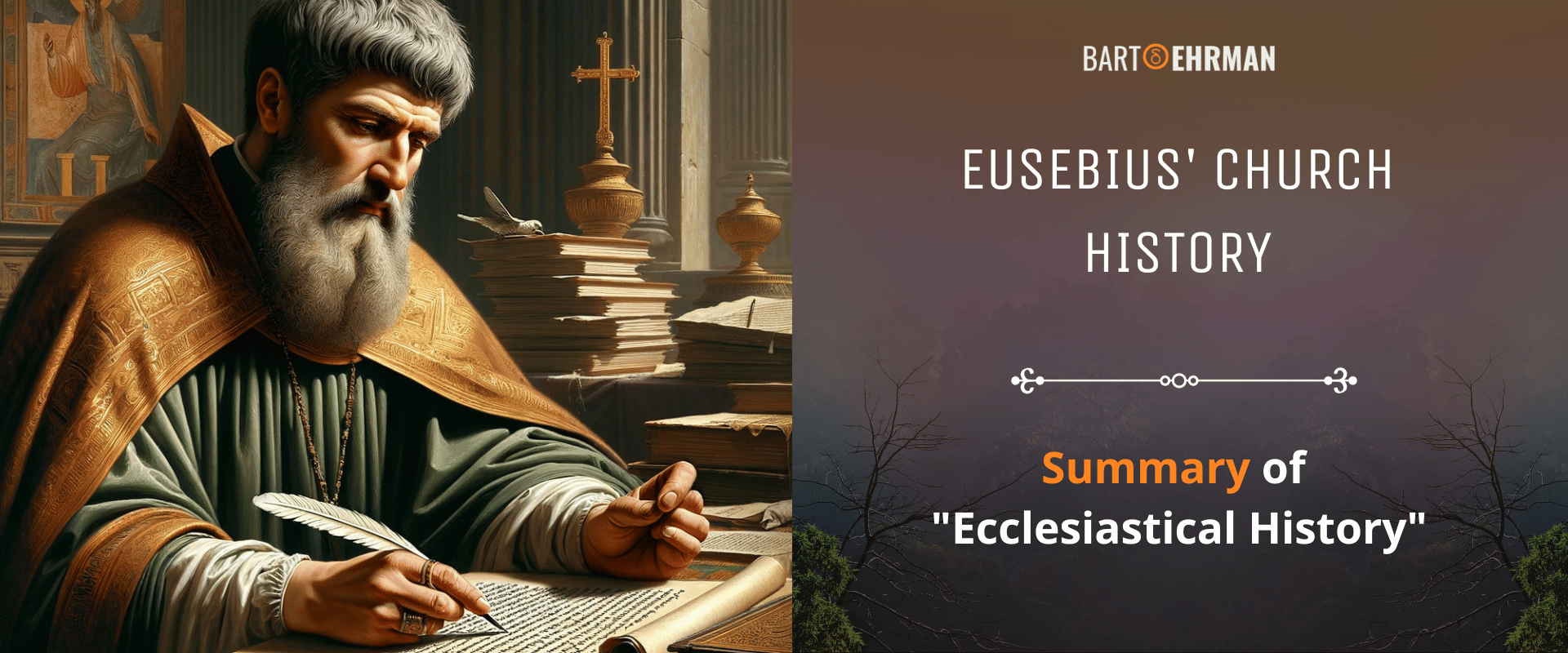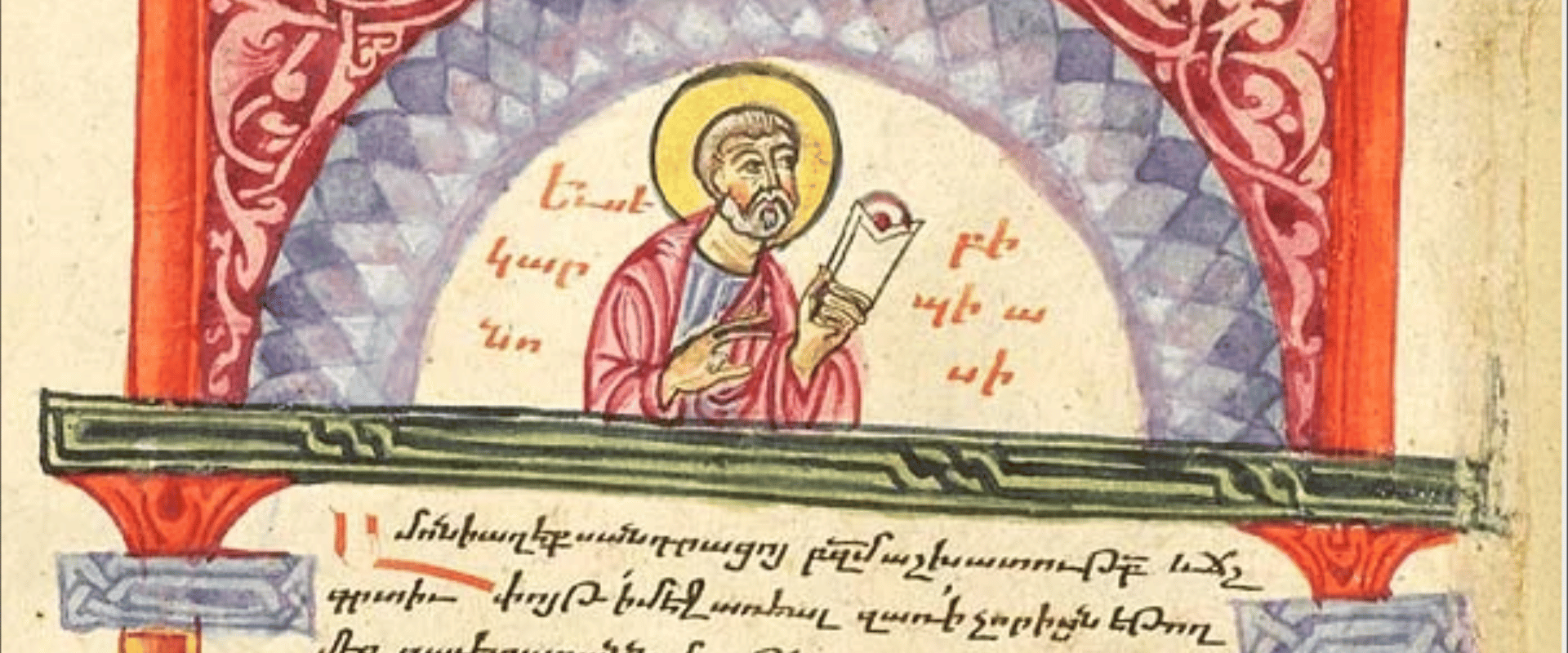Eusebius' Church History: Summary of "Ecclesiastical History"

Written by Marko Marina, Ph.D.
Author | Historian | BE Contributor
Verified! See our guidelines
Verified! See our editorial guidelines
Date written: January 9th, 2024
Disclaimer: The views and opinions expressed in this article belong to the author and do not necessarily match my own. - Dr. Bart D. Ehrman
In the vast expanse of early Christian literature, few works are as pivotal and comprehensive as Eusebius' Church History. This seminal work stands as a cornerstone of Christian historiography, offering an unparalleled glimpse into the formative centuries of the church and its relationship to the Roman Empire.
Authored by Eusebius of Caesarea, a historian, exegete, and polemicist, this text not only chronicles the tumultuous journey of early Christians but also provides critical insights into the theological debates that shaped the faith's trajectory.
As we embark on this exploration of Ecclesiastical History, we aim to dissect the methodological rigor and historical context of Eusebius' magnum opus. This article aims to acquaint a general audience with the pivotal figure of Eusebius, shedding light on his influential role in shaping the early church and bringing his historical significance into modern understanding.
Join us as we delve into the life of Eusebius, the era he documented, and the enduring legacy of his work, ensuring that scholars and enthusiasts alike appreciate the depth and breadth of "Eusebius’ Ecclesiastical history.
Interested in unraveling the mysteries of early Christianity? Dive deeper into the origins and complexities of the faith with Bard D. Ehrman's course, "Paul and Jesus: The Great Divide." Explore the pivotal question: Did Paul and Jesus share the same religion, or did their teachings diverge? Join the course now to discover the profound impact of their teachings on the foundation of Christianity.

Ecclesiastical History: Authorship and the Historical Context
Within the annals of Christian historiography, Eusebius of Caesarea emerges as a figure of monumental importance. His Ecclesiastical History provides not just a narrative of early Christianity but also an insight into the ideological and theological currents that shaped the late Roman Empire.
Born around the early 4th century, Eusebius lived through and documented some of the most transformative events in Christian history, including the Great Persecution and the rise of Constantine the Great.
Eusebius' chronicles serve as a bridge between the apostolic age and the post-Nicene period, capturing the growth, conflicts, and resolutions within the early church. His efforts were not merely to record history but to provide a theological and moral argument for the development of Christianity.
The historical context of Eusebius' work is crucial to understanding its content and impact. The early 4th century was a period of immense turmoil and transition for the Roman Empire and the Christian Church.
The empire, under Diocletian (284.-305. C.E.), saw one of the most severe persecutions of Christians, only for the situation to radically change with Constantine's Edict of Milan, granting Christianity legal status.
These events, along with the Arian controversy and the First Council of Nicaea, are meticulously documented and interpreted by Eusebius who offers a particular perspective on the political and theological dynamics of his time.
Eusebius' influence extends beyond his historical accounts. His work is a testament to the power of Christian historiography as a tool for theological argumentation and ecclesiastical legitimization.
Did You Know?
Eusebius of Caesarea, often called the "Father of Church History," was also known for his role in the creation of the first substantial Bible concordance. In his work "Eusebius' Canons," he created a set of tables (known as the Eusebian Canons) that cross-referenced the four Gospels of the New Testament. This early attempt at harmonizing the Gospels was a groundbreaking tool for biblical studies and is considered one of the earliest forms of a cross-reference system, illustrating Eusebius' innovative approach to scholarship and his dedication to the study of Scripture.
By situating the Christian narrative within the broader context of world history, Eusebius not only championed the legitimacy and supremacy of Christianity but also provided a model for integrating secular history with religious doctrine. His Church History remains a foundational text, reflecting the complexities and convictions of early Christianity and the late Roman Empire.
A Timeline of Tradition: The Dating of Eusebius’ Church History
Before we begin to look at the stages of compilation, it’s important to lay out the basic information about the Ecclesiastical history of Eusebius.
There isn’t any doubt: Eusebius' Church History is a foundational work in Christian historiography. It chronicles the formative years of the church from the time of Christ to the early 4th century.
Comprised of ten books, it documents the succession of bishops, the history of Christian martyrs, “heretical” movements, and the development of Christian doctrine, against the backdrop of Roman history.
Furthermore, thanks to modern technology and the internet, the Ecclesiastical History pdf is available on this link in a scholarly translation by Arthur C. McGiffert. What can we know about the process of compilation? When was it written?
The compilation and dating of Eusebius' Church History have long been subjects of scholarly debate, with various theories proposing different editions and timelines for its creation.
FREE COURSE!
WHY I AM NOT A CHRISTIAN
Raw, honest, and enlightening. Bart's story of why he deconverted from the Christian faith.
Over 6,000 enrolled!
A) Joseph Lightfoot’s theory
The seminal work by Joseph Lightfoot in 1880 laid the foundation for this discussion by suggesting two principal editions of Ecclesiastical History. According to Lightfoot, the first edition emerged post-Edict of Milan in 313, comprising Books 1 to 9, and a subsequent edition following Constantine's victory over Licinius in 324, adding the final Book 10.
This idea set the stage for a series of more nuanced theories that attempted to pin down the evolving nature of Ecclesiastical History.
B) Four Edition Theory
The debate further unfolded as Eduard Schwartz introduced a more complex four-edition theory, later modified by Hugh Lawlor, who suggested different timings and contents for these editions in response to specific historical and political events.
These early theories demonstrate the intricacies involved in understanding the creation and modification of Eusebius' work, reflecting both the changing times and Eusebius' engagement with ongoing theological and political developments.
C) Three Edition Theory: A Scholarly Consensus
Amid these various propositions, Richard Burgess' three-edition theory has emerged as a relatively stable consensus among modern scholars. Burgess suggests that the Ecclesiastical History underwent significant development through three major editions between 313 and 326, primarily composed by 316.
This perspective reflects a synthesis of earlier theories while addressing some of the complexities and contradictions presented in previous scholarship.
The evolving scholarly conversation around the compilation and dating of Ecclesiastical History underscores not only the historical importance of Eusebius' work but also the dynamic nature of ancient texts.
The varying theories highlight the challenges of piecing together the past, while the modern consensus leans towards understanding the work as a reflection of its time—shaped by the tumultuous period of the early 4th century, the shifting dynamics of the Roman Empire, and the maturing Christian church.
Eusebius’ Church History: Summary and Key Themes
Ecclesiastical History is more than a mere chronicle; it's a comprehensive account of the Christian church's development from the apostolic age to the early 4th century.
As a voluminous work divided into ten books, it documents the lineage of church leadership, the heroic tales of martyrs, the contentious rise of “heretical” sects, and the profound theological debates that shaped early Christian doctrine.
The first few books of the Ecclesiastical History set the stage by detailing the apostolic succession, starting from Christ and his disciples, and tracing the lineage through to the bishops of the major sees. This establishes a continuity of faith and doctrine, legitimizing the church's authority by linking it directly back to Jesus.
In the second book (2.9.2.-3.), for instance, Eusebius recounts (Acts 12:1-2) the story of the martyrdom of James the Apostle who died by Herod Aggripa’s sword for being a faithful follower of Jesus.
As the narrative progresses, Eusebius shifts focus to address the various heresies that challenged orthodox Christianity. By documenting these theological disputes and the church's responses, Eusebius provides a clear delineation between what he considered “heretical” and what was, for him and his supporters, “orthodox”.
Additionally, the latter books of Ecclesiastical History are particularly noteworthy for their detailed account of the Constantine era, highlighting the profound shift from persecution to imperial favor under Constantine's reign.
Eusebius' work is seminal not just for its content but also for its methodology. He made extensive use of available documents, letters, and other sources.
Bart D. Ehrman emphasizes the historical importance of Eusebius’ Church History: “This writing is our best source for the history of Christianity after the period of the New Testament to the time of the emperor Constantine, the first Roman emperor to convert to Christianity. The work is filled with anecdotes and, of yet greater use to historians, extensive quotations of earlier Christian writings.”
Does that mean that Eusebius’ Church history is accurate? There is no simple answer. His work is not without its biases; as a devout Christian and a supporter of Constantine, Eusebius’ perspective often shines through, particularly in his portrayal of Constantine as a quasi-messianic figure.
Furthermore, Eusebius’ theological perspective influenced his overall depiction of the relationship between different streams of Christianity. As a champion of “orthodoxy”, Eusebius often misrepresented other Christian communities by lumping them all under the category of heresy.
Moreover, Eusebius is widely credited with crafting the narrative that intertwines persecution, the valor of Christian martyrs, and the Church's identity. In his Church History, he selectively focuses on instances of valiant martyrdom while downplaying narratives of apostasy, thereby accentuating the steadfastness and virtue of early Christians.
Candida Moss highlights that this approach in Eusebius' writings served a definitive purpose. It was a deliberate effort by Eusebius "to improve the image of Christians, to bolster the position of the church hierarchy, and to provide security for orthodoxy."
James C. Webster concludes: “It should be apparent that Eusebius’ Church History is no simple recap of the first three centuries of Christianity. It’s rather a dramatic attempt to create a new vision of Christianity, in a new form, for a new world.
Modern historians should, therefore, tread carefully as they critically analyze Eusebius’ claims, perspectives, theories, and conclusions.

Book 3 of Eusebius’ Church History: A Glimpse into the Past
Book 3 of Eusebius' Church History provides a detailed account of the early church's structure, leadership, and challenges during the latter part of the 1st century and the beginning of the 2nd century.
He documents the succession of bishops in key patriarchates, particularly Rome and Antioch, emphasizing the continuity and legitimacy of apostolic authority within the burgeoning Christian community.
This section highlights the importance of episcopal leadership as a source of unity and doctrinal integrity, tracing the lineage of bishops who were believed to inherit the spiritual authority of the apostles.
Historians acknowledge the theological bias in Eusebius' narratives, which sometimes skews the early history of Christianity. For instance, in Book 3 of Ecclesiastical History, he posits that the apostle Peter was the inaugural bishop of Rome, succeeded by Linus.
Yet, contemporary scholarship often disputes such assertions for various reasons, including the observation that initial Christian communities in Rome, as shown by Paul’s epistle, likely didn’t have a single bishop as a leader. Moreover, Bart Ehrman highlights the scant early evidence supporting Peter's role as a leader in the Roman Church.
In addition to ecclesiastical succession, this book delves into the persecution of Christians under Emperor Domitian (81.-96. C.E.), marking a period of increased trials and tribulations for the faithful. These accounts served not only as a historical record but also as moral exhortations, inspiring readers with examples of unyielding faith and courage in the face of persecution.
Moreover, Book 3 of Eusebius’ Church History addresses the formation and recognition of canonical texts, discussing the chronological order and authorship of the New Testament Gospels. Needless to say, Eusebius accepts the traditional chronology and authorship of the Gospels - a theory rejected by the majority of critical scholars today!
If you want to know more about the authorship of the canonical Gospels, check out Bart Ehrman’s excellent course “The Unknown Gospels”!
Summing up Conclusions: Ecclesiastical History
Eusebius’ Church History is a monumental work that not only chronicles the early Christian church but also shapes our understanding of its trials, triumphs, and theological evolutions.
Its detailed account of the apostolic succession, martyrdom, heresies, and the development of Christian doctrine against the backdrop of Roman history offers an invaluable glimpse into the formative centuries of Christianity.
While the accuracy and objectivity of Eusebius' narrative may be subject to scholarly debate, its significance as a historical and theological document is undeniable.
As modern readers and scholars, we are tasked with critically navigating Eusebius' narrative, appreciating its depth and complexity, while also acknowledging its influence in shaping the historical discourse of early Christianity.
FREE COURSE!
WHY I AM NOT A CHRISTIAN
Raw, honest, and enlightening. Bart's story of why he deconverted from the Christian faith.
Over 6,000 enrolled!
